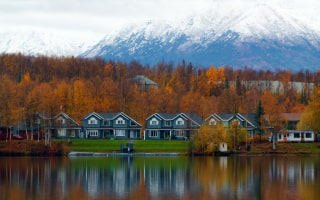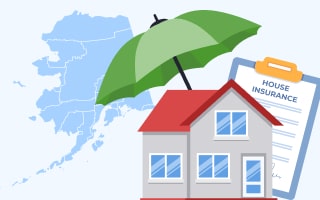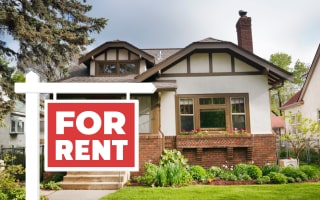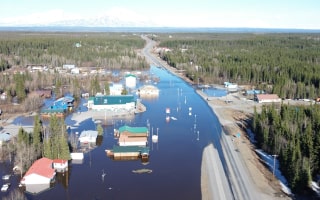Homeowners Insurance in Alaska

Alaska homeowners insurance is coverage that protects property owners in case of disaster. Weather conditions vary depending on where you live. If you are an Alaska resident, you may have to contend with earthquakes, wildfires, hurricanes, volcano eruptions, tsunamis, and landslides. Those are just some disastrous events that can severely damage or destroy your home. Alaska has more disasters per 1 million people (74.98) than any other state. There have been 55 federally declared disasters in Alaska since 1953.
Alaska is a snowy state with long, harsh winters, which can lead to frozen pipes, water damage, and ice and snow build-up, which can damage roofs and cause other home problems that require repair or rebuilding.
Although no states require homeowners insurance, it's highly recommended that everyone have some coverage. If you borrow money to buy the house, your lender will require that you have adequate coverage. You must fully understand those coverage limits and keep the home insured until the loan is paid off.
The national average home insurance rate is $2,728 per year. Comparatively, Alaskan homeowners only pay around $1,494, 54% less than the average in the U.S.
Types of Homeowner Insurance Coverage Available in Alaska
The types of homeowners insurance available in each state vary depending on where you live and the conditions. The following coverages are available in Alaska:
-
Dwelling Coverage: Dwelling coverage repairs or replaces the structure of your house, including the walls, roof, foundation, etc.
-
Liability Protection: If someone gets hurt while on your property or you damage someone else's property and they sue you, this coverage pays your legal bills.
-
Personal Property Coverage: Personal property coverage pays to replace or repair your personal belongings, such as clothing, furniture, and electronics, even if they are stolen while outside your home.
-
Guest Medical Coverage: If someone is injured on your property (like falling on icy steps), this coverage pays their medical bills.
-
Other Structures: Other structures coverage pays to repair or replace other detached structures on your property, like fences, sheds, and garages.
-
Additional Living Expenses: If you must leave your home after a disaster, this coverage will pay for you to live in a hotel and pay for food, laundry, furniture rental, and other expenses until you can move back home.
Since most homeowners insurance does not cover floods, supplemental flood coverage can repair damage and replace items after a flood. Even an inch of water can cause as much as $12,000 in damages. Flood insurance can cover the building and/or your personal belongings. The National Flood Insurance Program (NFIP) is managed by FEMA through a network of 50 providers across the U.S. and is available to homeowners, renters, and businesses. Learn more about the program on FEMA's website.
Home Insurance and Natural Disasters
The world is experiencing more crazy weather patterns than ever before. These trends impact the homeowners insurance market heavily and drive rate increases.
Increases in severe weather have impacted every state. In Alaska, rates increased by 6.4% from 2018 to 2023, which is low compared to other states.
Wildfires are common in Alaska. In 2022, 595 wildfires destroyed 3,110,976 acres of land. From 1980 until 2024, Alaska experienced eight billion-dollar natural disasters. Wildfires average $3.3 billion of damage. Hurricanes and windstorms are also problems in Alaska. The average claim for fire damage is $77,340, and the claim for wind damage is $11,695. Due to the snow and ice, Alaska also sees claims for damage caused by these weather conditions. An average claim for water damage or ice is $11,650.
How Can I Save on Homeowner Insurance Premiums in Alaska?
The cost of homeowners insurance is a concern for every property owner. As rates increase, you must find creative ways to reduce the expense of this vital insurance coverage. Some things that impact the cost of homeowners insurance are:
-
Location: Location is the number one factor affecting insurance rates. If you live in an area with severe weather or an urban setting with high crime rates, your premiums will be higher than if you live in a safe area with mild weather.
-
Size of the Home: Since the insurer will have to consider how much it will cost to rebuild your home, size matters. The larger the house, the more materials and supplies will be needed, therefore the higher the cost.
-
Condition: Before insuring your home, your carrier may perform a home inspection. If they find outdated systems or things in disrepair, you may have to pay more for your insurance by adding on riders and additional coverage.
-
Financing: If you finance your home, your lender will dictate how much coverage you need, and those limits could increase your rates.
-
Level of Coverage: The more types of coverage you have, the more you will pay for your premiums. You can add on extra liability coverage or supplemental flood insurance, but those will cost you extra.
-
Deductible: As with any insurance, the higher your deductible (the amount you are willing to pay), the lower your premiums. Conversely, your premiums will be higher if you choose a low deductible.
-
Claims History: Your insurance will increase if you have a long history of claims. Insurers see you as a high risk.
-
Cost of Materials: As the cost of materials and labor increases, replacing your home will cost more. Therefore, your insurance rates will go up accordingly.
-
Your Credit Score: Those with a higher credit score will earn lower premiums, and those with poor credit will pay more. The more risk you pose, the higher your expenses will be.
-
Additional Risks: Things like a pond, swimming pool, trampoline, hot tub, or dogs will add additional "perceived risk", and your rates will be higher.
If you live in Alaska and you want to save on your homeowners insurance, you can make a few changes:
- Increase your deductible.
- Only file claims when absolutely necessary.
- Rid your property of dangerous or risky items.
- Bundle your homeowners insurance with other policies to take advantage of discounts.
- Install a security system.
- Shop around when looking for coverage and explore available discounts.
- Fortify your home to withstand high winds, ice, snow, and other severe weather perils.
Home Insurance Discounts in Alaska
When you buy a home in Alaska, you must decide what homeowners insurance to buy, what provider to use, how much coverage, and choose a deductible you can afford.
You can start the process by exploring insurance company websites or contacting a local agent. You can even use online calculators to determine how much coverage you need and the estimated rates ahead of time. Compare companies and rates and choose the best policy for you, balancing coverage versus price. You must pay for the first year upfront, and then after that, you can pay annually or through your mortgage escrow.
With insurance rates climbing, homeowners must do all they can to reduce their insurance expenses. Some of the discounts available to you include:
- Senior Discounts: Some insurers offer discounts for seniors over a certain age.
- Professionals: If you work as a firefighter, teacher, or other type of professional, carriers may offer you a discount.
- Military: People in the military or veterans can shave money off their homeowner insurance by applying for discounts.
- Loyalty: When you have been a customer for a long time, some companies reward you by reducing your premiums.
- Auto Debit: If you let insurance companies deduct the monthly premium from your bank account, you might get a lower rate.
- Bundling: You can usually get your insurance for less if you bundle multiple policies with the same carrier.
- Claims-Free: If you go a certain amount of time without any claims, you might be entitled to a discount.
You may also get a discount if you install a security system, add other home safety features, or reinforce your structure. Non-smokers usually get discounts because of the reduced risk of fire. Environmentally friendly upgrades can sometimes earn you a discount.
Common Rates Offer by Homeowners Insurance Firms
Insurance rates depend on the insurance firm, homeowner profile, location, and other factors. Every state will have different rates due to climate, risks, and the local economy. New homes usually cost less to insurer than older homes, which require safety and material upgrades. The average cost of homeowners insurance on a new home is $80/month. On average, new construction homeowners save about 40% on insurance.
Top Ten homeowners insurance companies in Alaska and average savings.
| Company | % savings |
|---|---|
| Nationwide | 76% |
| State Farm | 51% |
| Allstate | 47% |
| USAA | 54% |
| Chubb | N/A |
| Liberty Mutual | N/A |
| Travelers | 63% |
| Country Financial | N/A |
| Umialik | N/A |
| Progressive | N/A |
Home Insurance and Renovations in Alaska

Older homes are more expensive to insure, which is why many homeowners choose to renovate and upgrade to improve the condition of their homes. However, renovations and remodeling projects can drastically impact your home insurance positively and negatively. In some cases, renovations will lower your costs; in others, they will raise them.
![]() Upgrades That Lower Your Premiums
Upgrades That Lower Your Premiums
- Safety/Security: Fix unsafe stairways, rotting decks, and other dangerous areas of the house to help save on your insurance. Install a security system, especially if you live in a high-risk area. You could earn up to a 5% discount.
- Upgrade Plumbing: Replace aged plumbing that could result in water leaks and damage. These upgrades could save you up to 10% on your insurance bill.
- Infrastructure Upgrades: After forty years, things like your foundation and electrical systems start to wear. Reinforcing or replacing these items enhances your structure and could save you up to 5% on your premiums.
- Storm-Ready: Make your home impervious to storm damage with a reinforced roof, hurricane shutters, or more robust windows, and you could save 5-20% on homeowners insurance.
![]() Upgrades That Increase Your Premiums
Upgrades That Increase Your Premiums
- Add-Ons: Adding square footage to your home adds value, which could increase your insurance rates.
- Luxury Upgrades: If you renovate your kitchen and install high-end fixtures and appliances, your homeowner's insurance premiums will go up because replacing all those will cost more money.
- Swimming Pools/Hot Tubs: Swimming pools and hot tubs increase risk and liability, increasing your rates.
- Finishing the Basement: Finishing the basement adds more room and value, which could also increase your rates.
- Solar Panels: Although solar panels help you use less energy, they will also increase the value of your house and, most likely, your rates.
Homeowners insurance pays for repairs and damage but does not cover renovations or remodeling. You will have to cover those costs yourself. Unless you experience a disaster that damages your plumbing, electrical, HVAC systems, foundation, or roof, homeowners insurance will not pay to upgrade those items; it will only fix or repair them after the event.
Before any renovation, ask your insurance agent how it will impact your coverage and rates. Be sure to have them reassess after the renovation and increase your limits so that if anything happens, they can restore the home to its new, upgraded condition. Provide your carrier with plans for the work, copies of permits, and estimates of how much the work will cost so they can help you adjust your coverage adequately.
Alaska Renters' Insurance

Even people who don't own homes need insurance. Renters insurance protects those renting apartments and houses. It's not the same as homeowners insurance but it covers some of the same things.
First, renters insurance comes in three flavors of coverage:
-
Personal Property: Personal property coverage replaces or repairs your personal belongings. It includes clothing, furniture, electronics, sports equipment, and other personal items. However, it does not cover anything beyond your limits, like expensive jewelry. Renters' insurance does not pay for pest or rodent damage.
-
Liability: Liability coverage fixes damage to other people's property or pays for medical bills if you injure someone accidentally. It does not cover car accidents, bodily injuries to you, property damage to your own items, or any intentional harm or damage.
-
Additional Living Expenses (ALE): If you must leave the home while it is repaired, you can get money for hotels, food, laundry, and other expenses until you return. However, this does not cover any structural damage to the home; the owner's policy must cover that.
Renters insurance is priced based on the location (cities and urban areas are more expensive), coverage limits, and the number of units in the building (the more units, the lower the cost). Each item will have a limit, and you can only claim up to that limit during a 12-month period.
Renters insurance is typically quite affordable and starts as low as $5/month. In Alaska, renters pay an average of $19/month or $223 a year for insurance for coverage limits of $40,000 for personal property and $100,000 for liability with a $1,000 deductible.
Condo Insurance in Alaska

Condo owners also need home insurance, which is different from regular homeowners insurance. A typical condo association has a master policy that includes all the structures and common grounds. It replaces or repairs the buildings after a covered event. However, that policy only restores the interior of each unit back to its original condition (which could be very outdated). Any condo owner with upgraded flooring, windows, doors, heating, appliances, kitchens, and baths will need an HO-6 condo insurance policy to restore those items to their current condition. Condo insurance includes nothing outside; it's strictly "walls-in".
Condo insurance covers the entire interior of your home (dwelling supplemental), along with personal possessions, liability coverage, and loss of use. On the other hand, renters insurance only covers personal possessions, not appliances, systems, or structural items. You can add liability, medical payments, and loss of use to your renter's policy.
All-in condo insurance covers appliances, wiring, plumbing, flooring, etc. A bare-walls-in policy does not cover anything inside the walls. In the event of a fire, storm, or theft, your condo insurance policy will cover:
- Appliances
- Furniture
- Interior walls
- Wiring and plumbing
- Carpets
- Light fixtures
- Countertops
- All other possessions
Mold removal and flood damage are not usually covered under your condo policy. You may also have limits on expensive items like jewelry and furs.
The average Alaska homeowner pays $695 a year or $58 a month for condo insurance, which has a $1,000 deductible and a $60,000 limit on personal possessions.
You can save on condo insurance by bundling it with other policies, installing a security system, signing up for automatic withdrawal, and increasing your deductible.
Alaska Home Insurance Market
The Alaska insurance market has experienced profit losses for the past ten years, and insurance rates have doubled during that period. However, the losses are far less than in almost every other state except for Vermont and D.C. As a result of these losses, insurers increased rates, narrowed coverage, and even dropped some customers.
Alaska experiences wildfires and storms with high winds, causing the most damage and increasing claims. When compared with the rest of the county, these perils impact the insurance market far less than other states.
State, rather than federal agencies, regulate and control insurance providers. In Alaska, the agency responsible for the professional conduct of insurance providers is the Department of Community and Economic Development, located at 3601 C Street, Suite 1324, Anchorage, AK 99503.
Homeowners Insurance Guide
- Homeowners Insurance in Alaska
- Types of Homeowner Insurance Coverage Available in Alaska
- Home Insurance and Natural Disasters
- How Can I Save on Homeowner Insurance Premiums in Alaska?
- Home Insurance Discounts in Alaska
- Home Insurance and Renovations in Alaska
- Alaska Renters' Insurance
- Condo Insurance in Alaska
- Alaska Home Insurance Market
Instant Access to Alaska Property Records
- Owner(s)
- Deed Records
- Loans & Liens
- Values
- Taxes
- Building Permits
- Purchase History
- Property Details
- And More!
Instant Access to Alaska Property Records
- Owner(s)
- Deed Records
- Loans & Liens
- Values
- Taxes
- Building Permits
- Purchase History
- Property Details
- And More!
Homeowners Insurance Guide
- Homeowners Insurance in Alaska
- Types of Homeowner Insurance Coverage Available in Alaska
- Home Insurance and Natural Disasters
- How Can I Save on Homeowner Insurance Premiums in Alaska?
- Home Insurance Discounts in Alaska
- Home Insurance and Renovations in Alaska
- Alaska Renters' Insurance
- Condo Insurance in Alaska
- Alaska Home Insurance Market